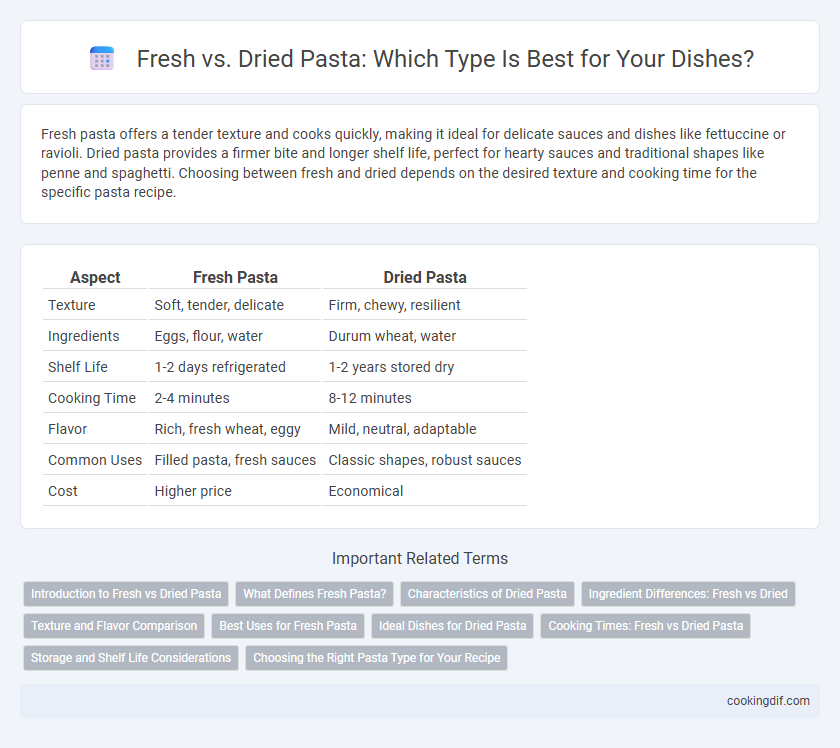Fresh pasta offers a tender texture and cooks quickly, making it ideal for delicate sauces and dishes like fettuccine or ravioli. Dried pasta provides a firmer bite and longer shelf life, perfect for hearty sauces and traditional shapes like penne and spaghetti. Choosing between fresh and dried depends on the desired texture and cooking time for the specific pasta recipe.
Table of Comparison
| Aspect | Fresh Pasta | Dried Pasta |
|---|---|---|
| Texture | Soft, tender, delicate | Firm, chewy, resilient |
| Ingredients | Eggs, flour, water | Durum wheat, water |
| Shelf Life | 1-2 days refrigerated | 1-2 years stored dry |
| Cooking Time | 2-4 minutes | 8-12 minutes |
| Flavor | Rich, fresh wheat, eggy | Mild, neutral, adaptable |
| Common Uses | Filled pasta, fresh sauces | Classic shapes, robust sauces |
| Cost | Higher price | Economical |
Introduction to Fresh vs Dried Pasta
Fresh pasta offers a tender texture and is often made with eggs, delivering a rich flavor suitable for delicate sauces and quick cooking times. Dried pasta, crafted from durum wheat semolina and water, boasts a firmer bite and longer shelf life, making it ideal for hearty sauces and extended storage. Understanding the differences in ingredients, texture, and cooking methods helps select the perfect pasta type for any recipe.
What Defines Fresh Pasta?
Fresh pasta is primarily defined by its high moisture content, typically made from a simple mixture of flour, eggs, and water, without preservatives or drying processes. Its soft texture allows for quicker cooking times and a more delicate flavor profile compared to dried pasta, which is dehydrated to increase shelf life. The use of durum wheat in dried pasta versus softer flours in fresh pasta also distinguishes their structural and taste characteristics.
Characteristics of Dried Pasta
Dried pasta is characterized by its firm texture and long shelf life, making it ideal for hearty sauces and extended storage. It is produced through a slow drying process at low temperatures, which preserves the durum wheat's robust flavor and nutritional value. Unlike fresh pasta, dried pasta offers a more consistent cooking time and maintains its shape well, even in boiling water.
Ingredient Differences: Fresh vs Dried
Fresh pasta contains higher moisture content and is typically made from eggs and soft wheat flour, which results in a tender texture and quicker cooking time. Dried pasta is made from durum wheat semolina and water, offering a firmer bite and longer shelf life due to its low moisture levels. The ingredient differences affect flavor absorption, with fresh pasta absorbing sauces more readily and dried pasta lending a more robust, al dente finish.
Texture and Flavor Comparison
Fresh pasta offers a tender, delicate texture that absorbs sauces more effectively, enhancing flavor intensity, while dried pasta features a firmer, chewier bite that holds shape better in hearty dishes. Fresh varieties, often made with eggs, provide a rich, buttery taste, contrasting with the neutral, wheat-focused flavor profile of dried pasta produced from semolina flour. The choice between fresh and dried pasta significantly influences the mouthfeel and flavor absorption in recipes like delicate seafood sauces versus robust ragus.
Best Uses for Fresh Pasta
Fresh pasta offers a tender texture and cooks quickly, making it ideal for delicate sauces like Alfredo, carbonara, or light tomato-based recipes. It pairs exceptionally well with simple, fresh ingredients that enhance its subtle flavor, such as fresh herbs, seafood, or cream sauces. Fresh pasta's pliability suits filled varieties like tortellini or ravioli, where the dough's softness complements rich, savory fillings.
Ideal Dishes for Dried Pasta
Dried pasta is best suited for hearty dishes like baked casseroles, thick sauces such as Bolognese, and soups due to its firm texture and longer shelf life. Its ability to hold shape during prolonged cooking makes it ideal for recipes requiring extended simmering or baking. Varieties like penne, rigatoni, and spaghetti perform well in robust, flavorful dishes where sauce clings to the ridges and surface.
Cooking Times: Fresh vs Dried Pasta
Fresh pasta typically cooks much faster than dried pasta, often requiring just 2 to 4 minutes in boiling water compared to 8 to 12 minutes for dried varieties. The higher moisture content in fresh pasta allows it to cook quickly, resulting in a tender texture that absorbs sauces effectively. Dried pasta, made from durum wheat semolina and low moisture, takes longer to cook but offers a firmer bite and longer shelf life, making it ideal for hearty, robust dishes.
Storage and Shelf Life Considerations
Fresh pasta requires refrigeration and typically lasts 1 to 2 days due to its higher moisture content, making it prone to spoilage. Dried pasta offers a significantly longer shelf life, often up to two years when stored in a cool, dry place, due to its low moisture content and dehydration process. Proper storage in airtight containers enhances durability, preventing exposure to humidity and pests for both pasta types.
Choosing the Right Pasta Type for Your Recipe
Fresh pasta boasts a tender texture and cooks quickly, making it ideal for delicate sauces like cream or butter-based recipes. Dried pasta offers a firmer bite and longer shelf life, perfect for hearty, tomato-based dishes or when you need a robust pasta that holds up in baked casseroles. Selecting between fresh and dried pasta depends on the sauce consistency, cooking time, and desired texture to create a perfectly balanced dish.
Fresh vs dried for pasta type Infographic

 cookingdif.com
cookingdif.com